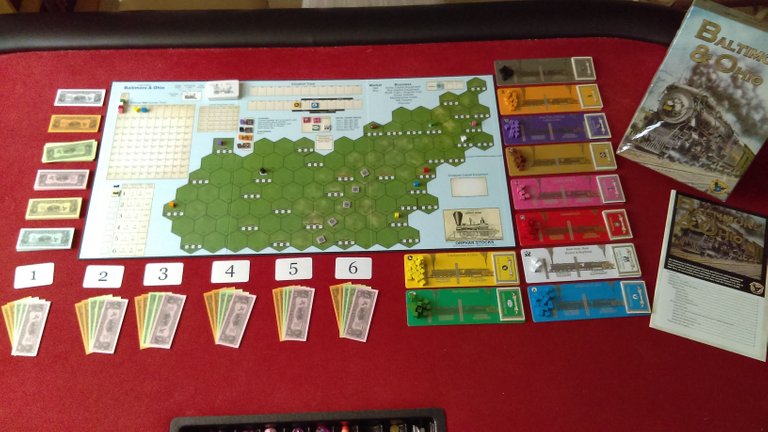What do I think about Baltimore & Ohio?
This game of math is interesting and interactive. You are an investor in Rail companies. As you buy stocks, the player with the most makes decisions on how the company expands.
Expand the railroad to a greater payout than the previous market round, pay out dividends, and you’ll increase the railway’s stock value towards end game points.
The game will take longer than 120 minute with certainty and never less. My shortest game, I believe, was 270 minutes? Perhaps the box should read 240+minutes.
This game does require a lot of math, addition (+), subtraction (-), multplication (x), division (/), and the ability to work with percentages (%). Albeit, if you don’t like math, you will not enjoy this game as almost, or literally, every turn requires some use of math; Monopoly is super easy compared to this.
Speaking of Monopoly, the way to win Baltimore & Ohio is to be worth the most by the end of the game.
Let’s talk components.
The intruction book.
This could use a few more images or diagrams to explain or show certain aspects about the game. Otherwise it is a no nonsense “how-to-play” book.
Let’s see...the game board.
The costs to extend track to new territories could be better for some hexes. Dark green colouring and black lettering makes a few spaces hard to read. The alternating coloured value spaces: black/white/black/white/black/white, is good and functional, however, a little bigger could ahve been tolerated.
The 10 charters for each railroad.
Good sturdy cardboard, similar to the game board. Solid.
100 stocks cards.
10 for each railroad. Quality enough considering they are never shuffled, but simply moved around as they are purchased and sold.
30 Capital Equipment cards.
These are not shuffled but set ina particular 1-30 order as numbered. 5 cards each of 6 different tech level, where the tech level also indicates the progression of technology and the game’s end at tech level 6.
6 Player Order cards.
Only shuffled once to determined original turn order at setup. Afterwards available cash directs turn order.
The cubes,
are sturdy and have their purpose to mark the progression of the rail system. The company even gives one additional cube for each colour in case one is lost.
Finally, the money. It’s paper, it sticks together, what else is new?

Baltimore & Ohio
“The Baltimore & Ohio Railroad became the first U.S. railway chartered for commercial transportation of freight and passengers. Investors hoped a railroad would allow Baltimore, the second largest U.S. city at that time, to successfully compete with New York for western trade.”
-Intro from Rules-
The game is played with 3-5 players, over (according to the box) 120+minutes, and rated for ages 13+.
playing with 2-players is just as easy for setup
Setup
- Lay gameboard in middle of table
- Divide $1,500 evenly among the number of players. (6-players: $275; 5-players: $300; 4-players: $375; 3-players: $500; (optional but not in rules)2-players: $750
- Place the Tech Level, Coal, and Market counters on their respective spaces on the game board. All the railway counters are placed near the Valuation Track and one cube of each is palced in the ‘0’ space of the Railroad Net Income track.
- Place the Capital Equipment Cards on their space on the board.
- (To save time during the game) Lay out the 10 charters; place the 10 matching stocks cards and the appropriate number of matching cubes: B&O (20 Blue), NYC (4 White), PA (18 Red), C&O (24 Yellow), B&M (8 Pink), NYNH&H (22 Green), and those available after Tech Level 3: Nickel Plate (12 Purple), Erie (16 Brown), Wabash (10 Black), and IC (14 Orange).
- Shuffle the appropriate number of order cards and disctribute to players. ‘1’ goes first, duh.
How to Play
Per “Sequence” there are 3 Rounds.
Market Round
This will be the round where players are swapping the railroad charters as ‘presidency’ may change due to majority stock holdings; in case of ties, the first player toahve the tied number of stocks retains ‘presidency’.
1a. In turn order, players decide if they want to sell any shares; as many as they want with one exception. 1 stock of each existing railroad must remain in someone’s hand.
1b. In turn order, player may now make purchases into one (1) railroad per turn. The purchasing phase continues one player at a time, in turn order, until all players pass consecutively.
Once you pass, you are out of the Market Phase.
1c. At the end of this round, any railroads with shares remaining in the orphaned stock area move one space down on the Valuations track.First Business Round
The railroad with the highest valued stock goes first.
Scrap old Capital Equipment
Buy new Capital Equipment (as tech level increases, so do values in the game)
Build Track; should a player have previously built into a coal space, the may instead of building new track, take the coal counter for additional income. Otherwise, pay the amount on the baord space to place new track.
Determine Gross Income.
Determine Maintenance Costs.
Determine Net Income and it’s effects
-If unprofitable (decreased Net); the company’s stock loses two (2) spaces on the Valuation Track.
-If profitable (increased Net) AND the president pays out dividends, the railway’s stock moves up one (1) space on the Valuation Track
-In all other cases the Valuation Track does not move.Second Business Round
Repeat 2. above.
-At the end of this round, in order of least to greatest cash hand out turn order cards. The player with the least Cash is first (1) and so forth.Check end of game conditions.
-Any railroad has reached the maximum of $375 on the Valuation Track OR Level 6 technology has been revealed.
Otherwise repeat Market/Business/Business rounds.
End of Game
Add up on hand cash + value of all railroad stocks = total wealth.
Highest wealth wins.